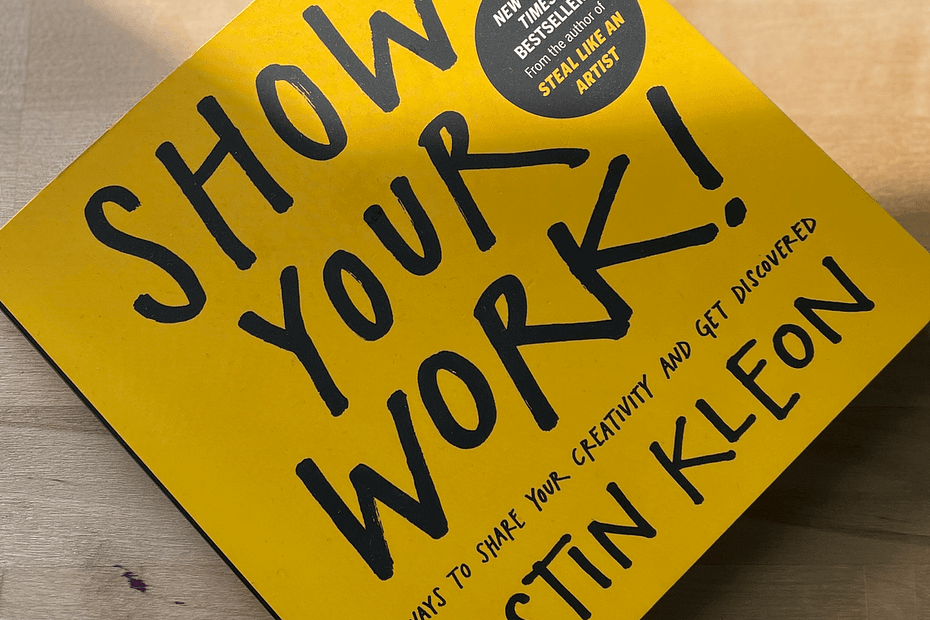Not savvy with social media? Don’t worry – just read on. I’ve summed up some basic pointers from Autin Kleon’s book. I’ve also created a checklist you can copy and paste at the end to help you on your social media journey!
There is a lot of advice about being more visible on social media, but the most comprehensive and often-quoted book (I feel) is Austin Kleon‘s Show Your Work (2014). It’s quaint in places because he talks about social media and smartphones at a time when they were still new and not all-pervasive in our lives! But as a useful book, it still holds up, and I highly recommend it!
Below, I’ve made some general notes of his advice for the shy (maybe fearful?) novice writer or entrepreneur trying to build up an audience and become more visible.
You have to be visible
You need to believe this to understand why using social media (or blogging or writing newsletters, for that matter) is important and worth doing. People need to know you exist and what your work is about. It makes no sense to create things without having an audience ready to know about your book, products or services.
Sharing isn’t invasive
You can decide what you want people to know about you and your work. Create your parameters. Begin with harmless pics that you are comfortable sharing. Share photos capturing your love of cooking or don’t. Share photos of your kids and pets or don’t. Share text from your manuscript or don’t. Share quotes from people that have inspired you or don’t. You decide.
Don’t be afraid of not being ‘liked’
Don’t treat zero likes personally. It’s not a personal rejection of you! It takes time for you to appear on feeds and for people to discover you. One of the ways they will discover you is if you post daily. Another way is through hashtags (I have a separate blog about hashtags). Having only a few followers can make it easier to post because it doesn’t matter if you make a mistake! Instead of thinking about likes and numbers, appreciate the audience that you have and chat with them – find out why they are interested in following you and what they are interested in.
Embrace being an amateur
Don’t worry about not being ‘good’ at social media. Being new to something can make you more interesting. Enjoy the learning process and expect to make mistakes. Be open about it. We tend to admire learning people.
Use social media to give, not just gain
Kleon (and many others) argue that using social media for self-gain is an empty approach. Use it with the mindset of giving. Give value to others. People are interested in processes and the personalities behind products. Offer some insights.
Creating content can be easy
Talk about what you love – your authentic voice will come through naturally.
Take a snapshot of something every day. Your desk, your notebook, walking your dog, shopping for groceries. It doesn’t matter. Posting every day helps boost your profile in the algorithm game (I’ve tried this for one week, and it’s definitely true – but I stopped and I dropped!).
Document the process of your work. If you have a project, take a photo (or video/reel) every day of you working on that project.
Kleon suggests showing things like scraps, stories from references and drawings, interviews pinboards, drafts (these all reflect processes). Non-fiction writers may find advice from Rob Fitzpatrick in How to Write a Book very useful. He talks about the ‘cutting room floor’, meaning you can use the things that get edited out as text for social media posts and to engage people.
Keep it light-hearted and entertaining.
Keep value in mind (being entertaining is also valuable).
Share your tastes. It requires being a bit brave. You may worry about driving people away, but the impact may be that ‘your people’ will be drawn to you. Examples of sharing your tastes can include books you’re reading, the music you like, movies you’re watching, collections, people you look up to, share other people’s work (always credit others and create hyperlinks to their work or sites).
Provide context for what you are sharing and why you are sharing it.
Be a good participant
Be kind, notice others and, if people comment on your post, reply. Follow people who interest you. Engage with other people’s posts (it really helps them algorithm-wise, and you may end up having an interesting exchange).
That’s it! Easy right?
Ready to go further?
Once you have the hang of posting daily without fretting about it, Kleon goes on to explain how to up your game by storytelling and teaching what you know. If you’re ready for that, then do buy his book. It’s short, sweet and encouraging!
Austin Kleon, Show Your Work!, Workman Publishing, 2014 (ISBN 978-0-7611-7897-2)
Checklist
You can copy and paste this as a checklist into your reminders app or calendar. Refer to it every day until you can post comfortably every day without referring to it.
- Post every single day! Posts can be small, harmless and within your own comfortable parameters.
- Use hashtags
- Give value. Does your post offer insight into your work or who you are?
- Respond to any engagement: be kind and friendly.
- Be a good participant: engage with other people’s posts.
Once you find this easy to do every day, and you aren’t overthinking each time you post, try advancing your skills by storytelling and teaching what you know.
